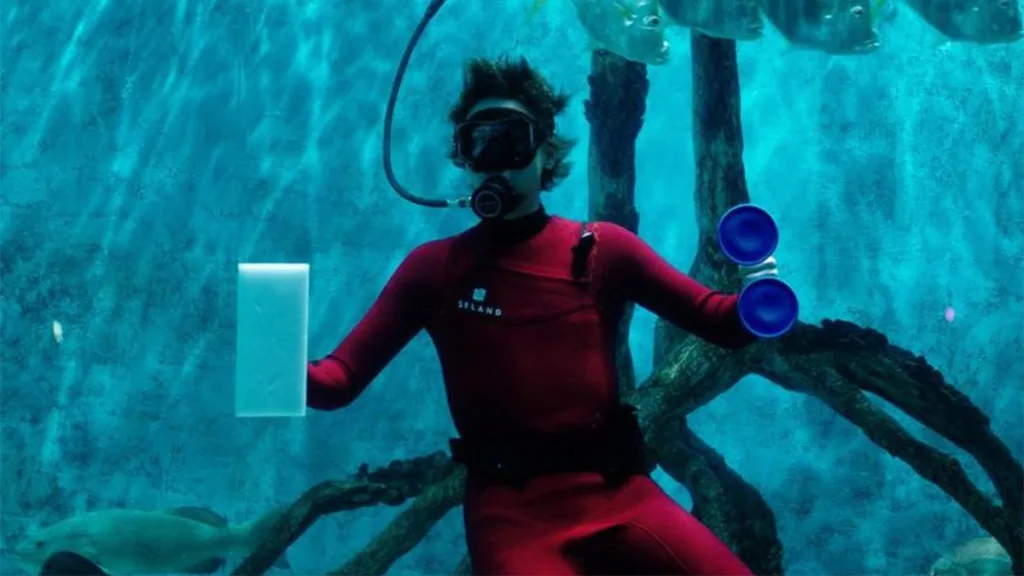“Mermaid” introduces us to a troubled man who stumbles into an unusual circumstance that turns his mundane life upside down. The film unfolds as a curious mix of horror, dark romance, absurd comedy, and satire, presenting a narrative that is both offbeat and emotionally charged. It tells the story of a man battling personal demons in a setting that feels almost like a character in its own right. A chance encounter with a creature from the deep marks the beginning of his transformation, setting the stage for a tale where loneliness and unexpected affection collide.
Tyler Cornack, known for his distinct approach to storytelling in his earlier work, brings a signature style marked by dry humor intertwined with a sense of melancholy. In “Mermaid,” his direction feels like a personal tribute to the state that provides the backdrop for this eccentric adventure.
The film’s dedication to Florida is clear, as its quirky culture and sunlit landscapes shape both the narrative and its emotional tone. This review will explore how the storytelling, character arcs, thematic elements, visual choices, and technical craftsmanship come together in “Mermaid,” revealing a film that examines isolation, personal redemption, and the surreal in a setting that pulses with local flavor.
Narrative Mechanics and Plot Progression
Doug’s story unfolds in a measured manner that starts with his everyday struggles and slowly builds tension through a surprising discovery. Initially, we witness a man whose life is steeped in routine hardships, set against a backdrop of personal isolation and responsibility. His world shifts dramatically when an unexpected encounter with an injured mermaid serves as the catalyst that drives the plot forward. This moment, charged with both shock and potential, creates an opening for new conflicts and emotional exploration.
The film establishes its pace through a steady, deliberate opening that allows the audience to absorb Doug’s mundane existence and the weight of his personal failures. Small details of his daily life are shown in quiet, reflective sequences, creating a sense of anticipation for the change that the mermaid brings.
As the narrative moves forward, key turning points are introduced—each marking a transition from absurd dark humor to sequences charged with personal vulnerability. These moments punctuate the story, shifting the tone and offering glimpses into Doug’s inner struggles and the consequences of his choices.
Intertwined with the central narrative are various subplots that enrich the storyline. Relationships with family and acquaintances, along with the presence of menacing figures from the criminal world, provide layers of conflict that complement Doug’s personal journey. The interactions with his daughter and ex-partner reveal the cost of his detachment, while the side characters linked to dangerous debts add an extra dimension to the unfolding drama.
A notable aspect of the screenplay is the oscillation between moments of absurdity and intense, personal drama. The mermaid herself emerges as a symbolic element—a mirror reflecting Doug’s deep-seated feelings of abandonment and his desperate need for connection.
The film’s structure uses this interplay of fantastical elements and grounded human experiences to evoke a range of emotional responses, prompting viewers to reconsider the relationship between fate and personal accountability.
Character Analysis & Performances: The Heart of Unlikely Bonds
Doug Nelson emerges as a figure marked by inner conflict and quiet despair. His portrayal captures the weight of a man burdened by habit and personal missteps. The depiction of his daily struggle is shown through subtle expressions and pauses that speak louder than dramatic outbursts.
A close look reveals a man caught between self-destruction and a search for meaning, as his encounter with the enigmatic creature forces him to confront his own isolation. His interactions with the mermaid hint at an unspoken need for understanding, suggesting that his actions, though flawed, stem from a deep longing for connection.
The mermaid, named Destiny, is presented in a manner that defies conventional expectations. With features that border on the grotesque, she serves as both a reminder of nature’s unforgiving aspects and an emblem of beauty found in unexpected places.
Her performance relies on body language and the power of presence, transforming her from a simple mythical being into a silent force that reflects the inner turmoil of her human counterpart. This balance of physicality and quiet intensity gives her a role that is as symbolic as it is visceral.
Secondary characters contribute significantly to the film’s portrayal of a troubled world. The figures surrounding Doug—ranging from a stern creditor to characters who populate the local underworld—offer a counterpoint to his personal struggles. Their distinct personalities add texture and context, providing a fuller picture of the environment in which Doug exists. Their appearances, delivered with a mix of dry humor and serious intent, create moments that resonate with the viewer.
Johnny Pemberton’s performance stands out through a careful mix of timing and understated energy. His expressions and pauses capture fleeting moments of regret and hope, building an on-screen chemistry that leaves space for the audience to interpret and feel.
Themes, Symbolism & Genre Exploration
Doug’s struggle with substance reliance and isolation creates a canvas that reflects deep emotional scars. His encounters with the mysterious creature shine a light on personal hardships, where his need for connection is palpable. The film portrays his daily battle with inner demons, as moments of self-reflection surface during his interactions with the mermaid.
This creature, dubbed Destiny, is cast in a light that challenges the classic image of a siren. Instead of the graceful and alluring figure found in old legends, she appears with a stark, unsettling presence that questions preconceived notions of beauty and desire. The choice of her name hints at an intertwined fate, suggesting that Doug’s path toward change is bound up with the survival of something as fragile as he is.
The narrative uses elements of off-kilter humor to point out a culture steeped in eccentricity. The portrayal of a state where bizarre headlines and unconventional lifestyles are commonplace contributes to an atmosphere that is both surreal and reflective of personal loss. This film shines a spotlight on lives that often exist in the shadows of mainstream society. It brings forward images of worn-out dreams and the weight of a disjointed community, all set against a backdrop where the unusual is a daily occurrence.
A careful play between harsh, unsettling imagery and rare moments of tenderness produces a texture that is both fragmented and thoughtful. Doug’s quest to reclaim some sense of self by caring for the injured mermaid hints at a larger picture of a man striving to mend what appears broken. Each narrative twist invites the viewer to consider whether fate is prewritten or molded by choices that oscillate between despair and the hope of renewal.
Visual Style, Production Design & Special Effects: A Closer Look
The film presents a striking visual approach that uses a mix of pastel and neon hues set against the unforgiving glare of Florida’s sunlight. The natural surroundings, with their sun-soaked landscapes and weathered textures, provide a raw, almost tactile atmosphere that mirrors the grit and underlying tensions in the story. This contrast of light and shadow creates scenes that feel both familiar and unsettling.
Attention to the set design is evident in every detail, from the laid-back look of the local characters to the unmistakable hints of beach culture. Costumes and props, featuring casual attire like cargo shorts and loose shirts, lend an authentic feel that grounds the film in its regional setting. Every visual element works together to craft an immersive environment that feels thoughtfully constructed.
A significant aspect of the film’s appeal lies in the practical effects and makeup, especially in the design of the mermaid. The creature’s look, crafted through skilled prosthetics and carefully executed special effects, brings a tangible presence to the fantastical. The visible effects—ranging from makeup textures to simulated blood and otherworldly substances—help bridge the gap between the surreal and the real, making the character’s impact all the more memorable.
Camera work and framing are used with precision to reflect the main character’s inner state. Strategic lighting and deliberate composition contribute to a mood that fluctuates between moments of absurdity and bursts of raw emotion, inviting the viewer to consider the interplay between personal turmoil and a world that seems both harsh and strangely poetic.
Sound, Music & Technical Aspects: Crafting the Audio-Visual Pulse
The film’s audio design marries a layer of yacht rock with pulsing club beats and eerie soundscapes, each selection tying tightly to the unfolding scenes. A calm musical passage accompanies moments when Doug’s solitude speaks volumes, while brisk rhythms signal abrupt turns in the narrative. These sound choices blend with visual cues, ensuring that each beat mirrors the film’s shifting moods.
The editing is smartly handled, with prolonged sequences that let moments of introspection breathe alongside sudden, unexpected bursts that capture the shock of escalating tension. This measured pace provides room for the story to feel both contemplative and surprising, with timing that perfectly supports the unfolding drama.
Technical expertise shows itself in the careful use of practical effects and crisp sound mixing. The tangible makeup work, especially on the mermaid, injects a reality that keeps the fantastical aspects grounded. Music and sound effects join forces with the visual style, resulting in scenes where subtle background scores heighten the emotional stakes of each confrontation or quiet reflection.
In some sequences, the soft strains of a track mirror Doug’s internal battles, prompting the viewer to sense his struggle without needing explicit dialogue. This synchronization of audio and visual elements leaves room for personal interpretation and invites ongoing thought about how technical details shape a truly memorable cinematic experience.
The Review
Mermaid
Mermaid offers a bold mix of surreal visuals and raw character studies that keep viewers engaged. Its unconventional take on folklore paired with a troubled protagonist creates an experience that is both memorable and thought-provoking. Although its pace can feel uneven, the film’s distinctive style and emotional pull make it a worthwhile watch.
PROS
- Striking visual design that blends pastel hues with stark natural landscapes
- Bold reinterpretation of mermaid mythology through practical effects
- Memorable lead performance conveying deep emotional layers
- Thoughtfully crafted audio-visual integration
- Engaging narrative that balances humor with poignant drama
CONS
- Secondary characters sometimes lack sufficient depth
- Pacing issues may leave some scenes feeling uneven
- Tonal shifts can be disorienting
- Certain narrative subplots feel underdeveloped


















































